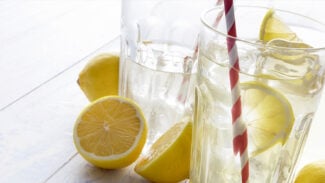Hiya Gorgeous!
Water, it’s essential to our health and survival. So it’s really important that we choose the best and most pure H2O available to keep us thriving.
But water can also contain lots of icky stuff we don’t want to ingest. From metals to chemicals, there’s a whole bunch of impurities that can make water look, taste and even smell bad (yuck!) Plus, some of these contaminants can be really, really bad for you.
So, how do we get rid of these pollutants? Water filters!
Filtering your own tap water and using a stainless steel or reusable glass bottle when on the go is really the best way to stay hydrated and healthy. And because bottled water is often just filtered tap, why not do it yourself? Especially when bottled water can come with issues that can find their way into our tissues (and our precious environment).
According to an investigation done by the Environmental Working Group, “PET plastics (the kind used to make plastic water bottles) can contain dozens of chemical additives, manufacturing impurities and breakdown byproducts. That’s more than 80 additional contaminants that could be leaching into your water.” That’s not tasty or healthy.
And if you’re an earth lover like me, did you know that around 80% of water bottles end up in landfills each year (and not recycled)? These bottles can release toxic chemicals as they decompose, chemicals that can find their way into the soil and waterways.
Speaking of water, according to Oceana an estimated 20 million tons of plastic ends up in the ocean each year. Sadly, many of our fish friends and other marine life often mistake the stuff for food! Plus, bottling alone uses up over 1.5 million barrels of oil in the U.S.
When you add it all up, the costs of bottled water are just too high for regular consumption. So let’s walk through how to clean up and drink your own wonderful water!
What’s in Your Water?
First, it’s helpful to know what’s in your water. Here are a few ways to find out the current condition of your H2O:
Check online
If you’re in the U.S., Environmental Working Group’s Tap Water Database lets you know which contaminants are in your water. Type in your zip code and see what comes up. You can also use your annual Consumer Confidence Report
Or you can contact your local water supplier to find out what’s in your local area (but they may not be able to tell you what’s specifically coming out of your tap).
And if you have well water, check out this info from the CDC on testing and treating.
Try an at-home test kit
Water test kits are available at home improvement stores, and sometimes through your local health department. It’s best to send the kit to a lab for analysis, so you can get the best results.
Check when your home was built
One big water contaminant is lead—which comes from pipes, not the water. The lead content in your water may be based on when your house was built. If your house was built in the U.S. before 1986, it is likely to have lead pipes. Find out what kind of pipes run into your house so you know if lead is something you have to factor into your filtering.
Why You Need to Filter
Once you’ve got a snapshot of what’s in your water, you can figure out how to improve it if needed. More than half of the contaminants found in drinking water aren’t regulated by the EPA. Some of these are known carcinogens and endocrine disruptors.
Even though your community may treat the water supply, here are some of the things that may be left in your tap by the time it makes its way to your home:
- Lead
- Pesticides
- Herbicides
- Detergents
- Chlorine
- Radon
- Antibiotics and other prescription drugs
- Hormones
- DEET
- Ibuprofen
- Arsenic
- Perchlorate
- Nitrates
How to Choose a Filter
After discovering what should be filtered out of your tap, there are a few things to consider:
- Determine the contaminants you need to filter and your budget, choose a filter with the NSF certification (world-wide certification) and make sure that the label lists the reduction or elimination of contaminants you’re specifically concerned about.
- How many people are in your house? Depending on how much water you need, can often determine the right filter for you. If it’s just you, a pitcher might do the trick or if you’ve got a whole house of water drinkers, then an under-the-sink or faucet-mounted option might work best.
- Check ratings on available filters through Consumer Reports, Environmental Working Group, and even the Best Sellers list on Amazon.
- Keep in mind that all filters need to be changed—don’t forget or you’ll have even more junk in your glass! And don’t forget to factor filter replacements into your budget.
Types of Filters to Consider
Under-the-Sink Reverse Osmosis Filters
If you want a water filter that pulls out the most icky stuff from your water supply, reverse osmosis (RO) is for you. It’s actually a method of water purification—a step up from filtration! Reverse osmosis eliminates 99% of contaminants, including ones the carbon filters can’t, like arsenic and perchlorate––making them one of the most effective filters.
Perks:
- Pulls out the most junk (powerful!)
- Simple to install and won’t take up counter space
- Great option for stretch faucets
Potential drawbacks:
- More expensive than carbon filters
- Slow filtration process
- RO systems generate wastewater in the filtration process. If water conservation is a priority to you, check out the amount of waste before choosing a specific brand. The more expensive ones tend to waste less.
Carbon Filters
Also known as activated charcoal filtration, carbon filters are a very affordable option. Mainly, these attract minerals and some toxic chemicals.
Perks:
- Lots of options: pitcher filters, faucet filters, countertop filters, undersink filters, refrigerator filters and even whole house filters
- Relatively inexpensive (just beware: they can vary greatly in price, quality, and water flow!)
Potential drawbacks:
- Won’t filter out fluoride, most toxic metals, or some small organic contaminants
- It’s super important to remember to change the filters regularly. Clogged filters support toxic bacterial and fungal growth
- A clogged filter is worse than no filter at all
Alkaline or Water Ionizers
A filter that uses electrolysis and passes the water over electrically charged plates to divide it into two streams: acidic water and alkaline water.
Perks
- Most water ionizers include 2 or more additional filters to filter out heavy metals, pesticides, and other contaminants based on your water filtration needs.
- Alkaline water contains antioxidants which may help boost your immune system. And may help your body in its constant effort to be in a more alkaline state.
Potential drawbacks
- Electrolysis alone will not filter out all contaminants, so make sure your system includes a filter that will also get the metals and other junk out.
- Since alkaline water is made alkaline by way of electrolysis, it doesn’t contain calcium and magnesium like natural alkaline water does. If you’re looking to augment these minerals, you’ll need to find them in your food or through supplementation.
- There’s no guarantee that alkaline water will improve your overall health (it’s rarely just one thing that gets us well! More like a combination of practices that balance our systems)
UV Light Purification Systems
These disinfection systems use UV light to disrupt the DNA of microorganisms eliminating their ability to function and reproduce. Over 99% of harmful microorganisms are destroyed without adding any chemicals like chlorine to the water, and no dangerous byproducts are produced.
Perks:
- Very little to keep up with or replace—just the lamp and sleeve about once a year.
- No waste water
- More effective than chlorine or chloramine on cysts
- No chemical taste to the water
Potential Drawbacks
- UV light filtration doesn’t eliminate anything other than microorganisms, so if you have additional icky stuff to filter out, you’ll need another for filtration and purification
- Needs electricity to operate (although very little)
- Expensive up front, but low costs to maintain system









Since my third round of Lynch Syndrome related cancer last year (endometrial stage 4), I have been following and practicing many of your tips. We purchased a Berkey countertop water filter which does filter out fluoride and chlorine. Whenever we have guests visit we ask if they want to guess the Chicago tap water vs our filtered Berkey water, and so far, only one person could not tell a difference.
Personally, I give huge credit to my wonderful water for my still being here!
So wonderful, Cathi. Thank you for sharing. xo, kc
Just bought a Berkey last week. Love it. (I’m also in Chgo, I realized that my years-old Pur in-fridge dispenser wasn’t removing lead) Praying for your good health, Cathi. xo
…following up here – I’ve had my Berkey countertop filter for a few years now and I still love it. The water takes a bit of time to filter (doesn’t seem to be quite as quick as a Pur or Brita?) – but once you get used to it, it’s fine. Grateful!
>Whenever we have guests visit we ask if they want to guess the Chicago tap water vs our filtered Berkey water, and so far, only one person could not tell a difference.
That person must have had no taste buds… lol… the difference between tap water and RO water is like night and day. Or maybe Chicago tap water is just really good? 😀
I’m a huge fan of the Berkey filter system. I keep my Berkey on my kitchen counter and it’s fun to say the word “Berkey”.
Agreed! 🙂 xo, kc
Thank you Kris!!!! We Live in Colorado and have a well. There is not very much information on what is the best system to have with a well. It’s very hard water and leaves lime deposits on everything….scary!!!
Do you have a recommendation?
If you have well water, check out this info from the CDC on testing and treating: http://bit.ly/2hrjkpi xo, kc
Also, a lot of well water is very pure and uncontaminated, but depending on what’s in it, you may need to consider a whole house filtration system that also has a softener. This also helps to protect your plumbing and appliances. Hope this helps! xo, kc
Hi Kris~. I love you!!!!! You totally ROCK
I use the Kangen water system and three large pre-filters for my drinking water.
My concern is I’v heard that the shower filter is more important than the water we drink? What are your thoughts on this? I do use an aqusana filter on my shower and wonder if that is enough.
Thank you for all you do.
Namaste,
Sandy Contento
The main concern with shower water is if your water is high in chlorine as that can get into your body in more concentrated doses through skin and steam inhalation than drinking water. High chlorine water also results in more chloroform in your household air. You may want to test your water for chlorine content (using strips or dyes which are available on Amazon), but also know that the Aquasana shower filters are highly rated for getting chlorine out. Hope that helps! xo, kc
I have been debating which system to get for some time and I was wondering what your thoughts were on the Berkey filter and why it wasn’t mentioned. Thank you.
…also, I have been using a chlorine-removing shower filter for over 10 years now. I love it – not breathing in that chlorine any longer. And my hair feels so much softer – skin not so irritated/dry – esp in winter. I have an older-model April Showers filter – but the company’s latest filters are on this site… www(dot)showerfilterstore(dot)com
Very nice blog, thanks for sharing.
Nice blog.Thanks for sharing this useful information.
I use Reverse Osmosis Systems and it is excellent. Filter fluoride in water, which is most useful feature to me. A reverse osmosis system is a specialty filtration system and is considered to be among the most rigorous types in the market today.
My dad is a scientist and he was testing water treated with UV light, he found that it contained a lot of free radicals, so basically the water eroded everything it came in contact with overtime (like your pipes) and it also causes a host of health issues including cancer. I definitely don’t recommend it.
Thank you so much for writing such an interesting and informative blog. I must appreciate the way you write the blog. Keep writing and spreading the knowledge.
Hi,
I really need this. Nowadays water is not safe, so to make sure that the water we are drinking is safe we need this Berkey water filter. Great review about this product and I’m impressed that it even filters fluoride. Thank you for sharing.
What is your opinion on reverse osmosis filtered water? Is it safe to drink as your main source of water since the minerals are filtered out?
My house has an old pipeline but APEC Portable Countertop Reverse Osmosis Water Filter System solves all my problems.
I just wonder how to get the best one? I have fixed budget as $500. Please suggest the suitable one. Thanks.
Awesome. I will get one for my own use at home. Thanks for your suggestion.
I’m a huge fan of the Berkey filter system 🙂
This article is excellent, Kris!
I think many people (including myself) don’t think about all the gross stuff that’s in our water. And, that’s just drinking water! Imagine what’s in our shower water…yuck!
Most of the time I try to use a Brita filter, but even then, I forget to change it out when the filter expires. Sadly (up until recently) I wasn’t taking this issue very seriously.
However, I’ve been looking into water purification options, and just found out that something simple as water softening systems can make all the difference for our skin, hair, and overall quality of life.
I’m strongly thinking about investing in one…do you have any recommendations?
Thanks again for this well-written piece! 🙂
Please tell me what water filter measures up to home drinking non toxic water. All the cons in everyone that is suggested I’m confused by the list. Live in the Bay Area and our water is not good without some alternative to clean water. I’m confused
Thanks for sharing. This is very nice blog about water filter.